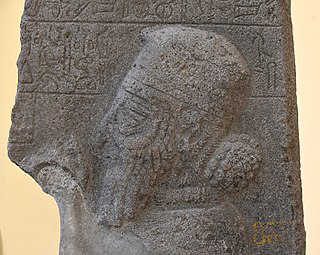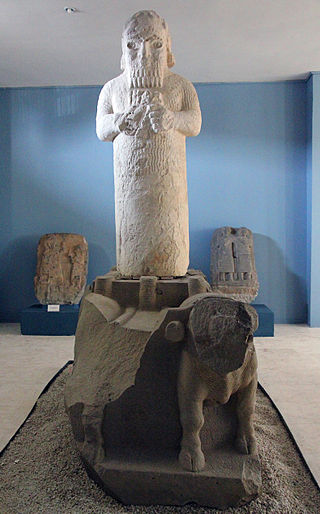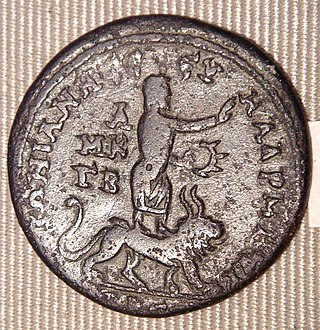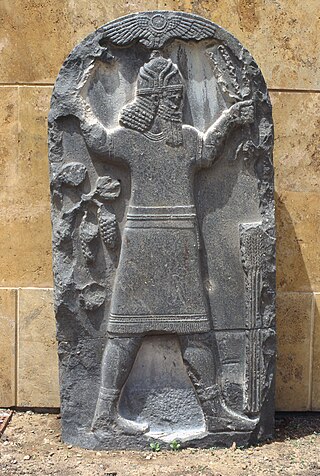Mopsus was the name of one of two famous seers in Greek mythology; his rival being Calchas. A historical or legendary Mopsos or Mukšuš may have been the founder of a house in power at widespread sites in the coastal plains of Pamphylia and Cilicia during the early Iron Age.

Luwian, sometimes known as Luvian or Luish, is an ancient language, or group of languages, within the Anatolian branch of the Indo-European language family. The ethnonym Luwian comes from Luwiya – the name of the region in which the Luwians lived. Luwiya is attested, for example, in the Hittite laws.

Kadirli, historically Kars or Karsbazar, is a city in Osmaniye Province in the Mediterranean region of Turkey. It is the seat of Kadirli District. Its population is 98,469 (2022). It is located in the Çukurova plain, 41 kilometres from the province's capital, Osmaniye. It is located near the ancient site of Flaviopolis.

The Denyen is purported to be one of the groups constituting the Sea Peoples.

Ḫiyawa was a Syro-Hittite Assyrian vassal state or province at various times from the 9th century BC to shortly after the death of Ashurbanipal around 627 BC in the lowland areas of eastern Cilicia corresponding to Classical Plain Cilicia, and the name of its capital city, tentatively identified with Adana, in modern Turkey.

Hieroglyphic Luwian (luwili) is a variant of the Luwian language, recorded in official and royal seals and a small number of monumental inscriptions. It is written in a hieroglyphic script known as Anatolian hieroglyphs.

Warpalawas II was a Luwian king of the Syro-Hittite kingdom of Tuwana in the region of Tabal who reigned during the late 8th century BC, from around c. 740 to c. 705 BC.

The İvriz relief is a Hittite rock relief in south-central Anatolia, located in the town of Aydınkent, formerly called İvriz. The rock relief is on a rock face near the source of the İvriz Suyu, whose water has damaged the relief in modern times. It depicts the late 8th-century BC king Warpalawas and the storm-god Tarhunzas and is accompanied by a hieroglyphic Luwian inscription. Rock reliefs are a prominent aspect of Hittite art.

Karatepe is a late Hittite fortress and open-air museum in Osmaniye Province in southern Turkey lying at a distance of about 23 km from the district center of Kadirli. It is sited in the Taurus Mountains, on the right bank of the Ceyhan River. The site is contained within Karatepe-Aslantaş National Park.
The Luwians were an ancient people in Anatolia who spoke the Luwian language. During the Bronze Age, Luwians formed part of the population of the Hittite Empire and adjoining states such as Kizzuwatna. During the Hittite New Kingdom, Luwian replaced Hittite as the empire's dominant language. In the early Iron Age, a number of Luwian-speaking Neo-Hittite states arose in northern Syria. The Luwians are known largely from their language, and it is unclear to what extent they formed a unified cultural or political group.

The Çineköy inscription is an ancient bilingual inscription, written in Hieroglyphic Luwian and Phoenician languages. The inscription is dated to the second half of the 8th century BC. It was uncovered in 1997 near the village of Çine, that is located some 30 km south of Adana, capital city of the Adana Province in southern Turkey.

Šanta (Santa) was a god worshiped in Bronze Age Anatolia by Luwians and Hittites. It is presumed that he was regarded as a warlike deity, and that he could additionally be associated with plagues and possibly with the underworld, though the latter proposal is not universally accepted. In known texts he frequently appears alongside Iyarri, a deity of similar character. He is first attested in documents from Kanesh dated to the Old Assyrian period, and continues to appear in later treaties, ritual texts and theophoric names. He is also present in an offering lists from Emar written in Akkadian, though he did not belong to the local pantheon and rituals involving him were only performed on behalf of the Hittite administration by local inhabitants.

The Niğde Stele is a Neo-Hittite monument from the modern Turkish city of Niğde, which dates from the end of the 8th century BC.

Ḫartapus or Kartapus was an Anatolian king who in the early 8th century BCE ruled a state in what is presently the region of Konya in modern Turkey.

Karatepe-Aslantaş Open-Air Museum is an open-air museum in Osmaniye Province, Turkey. Karatepe is the location while Aslantaş refers to the lion figure on stone sculptures. The site is situated inside a national park with the same name.

Karatepe-Aslantaş National Park, established in 1958, is a national park in southern Turkey. Situated on the banks of a dam reservoir, it contains an archaeological open-air museum.
Helmuth Theodor Bossert was a German and Turkish art historian, philologist and archaeologist. He is best known for his excavations of the Hittite fortress city at Karatepe, Turkey, and the discovery of bilingual inscriptions, which enabled the translation of Hittite hieroglyphs.
Bahadır Alkım Bayraktar was a Turkish archaeologist.

Tarḫunz was the weather god and chief god of the Luwians, a people of Bronze Age and early Iron Age Anatolia. He is closely associated with the Hittite god Tarḫunna and the Hurrian god Teshub.

Runtiya was the Luwian god of the hunt, who had a close connection with deer. He was among the most important gods of the Luwians.



















